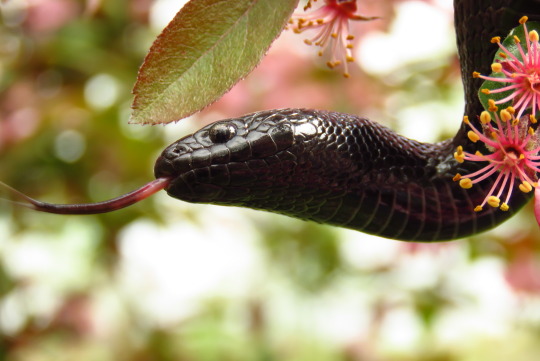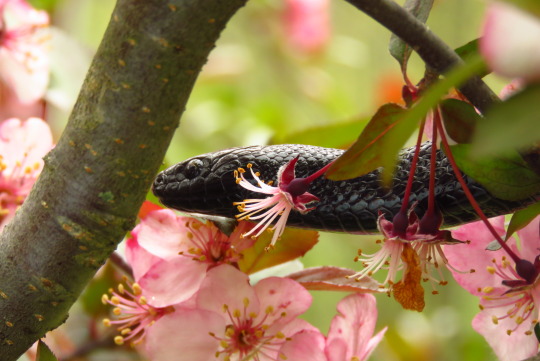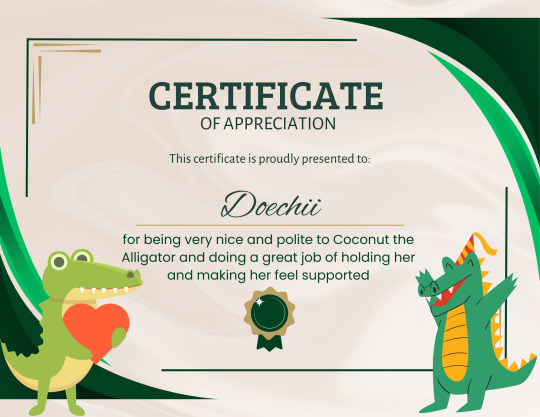#reptiblr
Explore tagged Tumblr posts
Text
"snakes dont have personalities!" Leliana, after 11 years of life: "OMG water is wet??" Watch until the end 😂
12K notes
·
View notes
Text



I had to clean Ed's viv up a bit today, so i decided to rearrange it too! Moved some of his branches (but left the beloved sleeping one alone), added the snake plant, and added a bigger water bowl. Waiting on fb group to verify if the bowl will be okay or too risky - I added the rock for better grip so he won't slip on the metal.


Ed was a bit skeptical on the hand vacuum being near him, so he went out to hang out with Jack. He decided he had beans to spare & wanted to jump & run! So they got the playpen set up for him. He got a good workout climbing the walls. 😂



After he started slowing down, I took him back home to see the changes. He took a minute to inspect my work, mlemed a couple times as he moved down my arm, then seemed to approve & hopped to his basking spot!
I love this scaly man so much.
#reptiblr#reptiles#bearded dragon#beardie#ed beardie#my pets#animal pics#fbw rambles#he's such a good and chill boy#i hope he likes the change up#been a while since i messed with his viv much#i AM going to get him changed to loose substrate this summer#i AM damn it
11 notes
·
View notes
Text

My perfect thick idiot son, Calvin, who has never done anything wrong in his entire life except today when I let him climb my young redbud tree and he went to the highest branch and wedged himself in the crook of it and wouldn't budge and he's so big I was afraid that he might break the branch so I had to get a stepladder and get him down while the neighborhood jays that come by for peanuts whenever they see me in the yard freaked out and sat screaming on the fence to warn me that there's a snake very near me because I'm obviously too stupid to see it and clearly in mortal peril.
#thanks Calvin#thanks jays#snake#snakes#reptile#reptiles#reptiblr#rat snake#Texas rat snake#scaleless Texas rat snake#rat snake = brat snake#Calvin
27K notes
·
View notes
Text
The first thing you should do when considering buying a new pet is — absolutely, without a fucking doubt — make sure that here’s a reliable 24/7 vet (within 20 minutes of you). I cannot stress this enough. Before you put any care at all into figuring out its needs, looking up price tags, or searching for breeders. And I don’t just mean google “vets in my area” and move on, I mean make sure.
Do they have surgical facilities? Are they equipped to care for the specific animal you’re getting? What times are they open? Not to mention, do they even accept the animal you’re planning on getting?
If I could imbue everyone on earth with a single piece of knowledge, at this very moment, it would be that (most) rodents and birds are very much considered “exotics” — especially beyond the US — and a good 75% of regular vets can’t care for them. Whether it’s due to lack of facilities, or just plain inexperience.
I know that many end up with animals through luck or happenstance, but a considerable number go into pet shops and buy animals with the frankly terrible (though often subconscious) notion that it just “won’t happen to them.” For your pet’s sake, don’t be one of them.
#no one panic-uploading photos of their dying pet on reddit thought it’d happen to them#and yet#just be responsible for the love of god#mouseblr#rodentblr#fancy mice#fancy mouse#mouse#ratblr#reptiblr#bugblr#snakeblr#frogblr#petblr#birdblr
98 notes
·
View notes
Text
🚨Urgent : Help me evacuate my family from the Gaza war .
Der human, my supportive friends 🙏
I am Ahmed, I am 24 years old I live with my family of 4people My married sister and her two daughters Our house is gone and we are now living in a small tent that is not fit for living and we are losing the most basic necessities of life





I am the head of my family after my father passed away in 2011 and I was looking for a job. To help my family with expenses



Please help me and my family by donating, sharing or reblogging🙏.
This is my sister's account @azeza-dhlan
Vetted by @gazavetters, my number verified on the list is ( #130 )
#free gaza#gaza strip#the female gaze#resmi gazete#gaza#gaza genocide#mutual aid#@siraj2024#ratblr#reptiblr#black cats
4K notes
·
View notes
Text
Sunny doin' a sipp after a busy morning esplorin
Remember, hydration is important!
667 notes
·
View notes
Text

if chilchuck were a snake he'd be called checkleheck teefs
Edit: If you enjoy Checkleheck, consider helping me here
24K notes
·
View notes
Text



Toast in the crab apple tree!
6K notes
·
View notes
Text
Alligator Bites Might Never Heal, But Doechii Is Good At Holding Alligators
Doechii won the Grammy for Best Rap Album for Alligator Bites Never Heal, but she also should have won the coveted and definitely not fictitious "Best Alligator Handling" award for the way she held Coconut on the cover!



(Yes, it's this Coconut.)
And the best part? She released a BTS video showing how they shot the cover, meaning that we can see more than just the still image! If a picture's worth a thousand words, video's worth... a lot more. (Sorry if it autoplays I don't think I have any control over that either way)
So, using the photoshoot images and video as evidence, let's take a look at how Doechii handled this alligator very well! I'm going to go into excruciating detail here because I think it's important to know why something is good just as much as it is important to know why something is bad. It's hard to understand alligator body language a lot of the time, so in this writeup, I will address how Doechii's holding the gator and what she's doing right, as well as point out how you can tell from Coconut's reactions that she is not distressed.
Body Support
In the album cover image, Doechii is seated, which is good, because even though she's a small alligator, Coconut is a very strong and powerful creature. That tail is pure muscle! But even in the standing images, you can see that Doechii is giving Coconut great body support and holding her correctly- close to the body, but without grabbing too tightly or being restrained uncomfortably. I think for a gator of this size I would have recommended pinning the back foreleg against her body for a little additional support and movement restriction- but I don't think she had to restrict movement because Coconut seems quite relaxed!
In the seated image, Doechii has one hand under Coconut's chest, supporting her sternum and head. The other hand is on top of her tail, and her knee is under the pelvic girdle. This type of hold lets the alligator feel safe; remember that these are aquatic and terrestrial creatures. An insecure hold that risks dropping them is going to stress them out and make them uncomfortable. By holding the alligator gently against her body and not squeezing, she's avoiding any uncomfortable pressure.
Head and Throat Support
In all of the images, Doechii is bringing her hand under Coconut's neck, creating a cradle with her hand so that the alligator can rest her head. But what she's not doing is she is not squeezing or grabbing the throat. The throat is one of the soft bits of an alligator, and squeezing it too tightly is very uncomfortable for them. But the way Doechii is supporting her gives her several degrees of freedom to move her head if she so chooses.
Body Language
Another indication of good handling is that it's clear that Coconut is not uncomfortably stressed. Alligators express displeasure with being held in a lot of ways, including struggling to get away, hissing, and holding their mouths open. (If you want to know more and see my sources, you can read my post on alligator body language. LOTS of info there, including peer-reviewed ethology sources that explain what alligators do and why they do it! Go get your data-driven answers!)
But Coconut isn't doing that; she's calm and alert. You can see in the BTS video that she's active on set. She's not shut down, and when she wants to walk around, she's not restrained. Obviously the video is an edited timelapse, and it's not the whole story- but when people show alligators in media, they usually don't know enough about them to edit out any uncomfortable body language. So I think that if she had been upset, we would have seen that.
We can also see in the video that Coconut is unbanded, meaning her mouth was not held shut. I thought they might have banded her and then edited the band out for the cover, but no, there was nothing restricting any distress cues. Banding is usually done for public safety, but the facility Coconut's from... doesn't do that, so I'm not surprised she's unbanded. At least it gives more evidence that she's not trying to gape!
One more good indicator that Coconut was comfortable is that she's got her eyes open, which you can even kinda see in the video if you zoom in. Reptiles will often squinch their eyes shut to avoid distressing stimuli or signal distress, and albino alligators have even more reasons to do this. They're much more sensitive to light than their pigmented counterparts. But it looks like her on-set work was completed quickly, meaning that she didn't have to be around bright lights for long.
In conclusion:

Doechii's album cover is an example of good alligator handling. Yay!
That said, please note that this is only about handling and is divorced from any other issues surrounding this particular alligator. (Read the body language post if you want more on that.) These are not issues I'm touching in this post, because that's not the point! I simply want to point out an instance of good handling and how you can identify relaxed body language in an animal that is notoriously hard to read when posted on social media.
10K notes
·
View notes
Text
He's getting so big already! 🥰
36 notes
·
View notes
Text
Recipe
* bwol
* 1 noodle
* butter (to taste)
ENJOY

8K notes
·
View notes
Text

Hognoses are truly the most relatable snakes
Patreon | Etsy
#hognose snake#herpetology#heterodon nasicus#artists on tumblr#snakes#squishyfauna#digital art#reptiblr#patreon#etsy#herpetology memes#snake memes
10K notes
·
View notes
Text

you dont need to smell the camera
Editing: This is Tonic! He is a carpet python!
#tablogging#tabaquiscreatures#carpet python#snakes#reptiblr#reptiles#tonic#1k#containment breach#3k#5k#10k
16K notes
·
View notes


